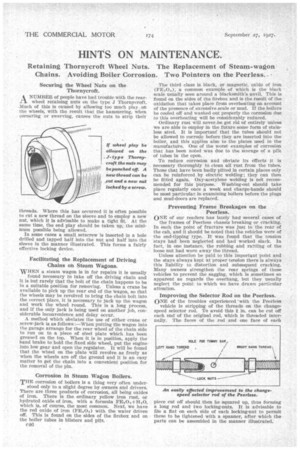HINT'S ON MAINTENANCE.
Page 68

If you've noticed an error in this article please click here to report it so we can fix it.
Retaining Thornycroft Wheel Nuts. The Replacement of Steam-wagon Chains. Avoiding Boiler Corrosion. Two Pointers on the Peerless.. •
Securing the Wheel Nuts on the Thornycroft.
t NUMBER of people have had trouble with the rear13. wheel retaining nuts on the type J Thornycroft, Much of this is caused by allowing too much play on the wheels, with the result that the hammering, when cornering or swerving, causes the nuts to strip their
threads. Where this has occurred it is often possible to cut a new thread on the sleeve and to employ a new nut, which it is advisable to make a tight fit. At the same time, the end play should be taken up, the minimum possible being allowed.
In some cases a small setscrew is inserted in a hole drilled and tapped half into the nut and half into the sleeve in the manner illustrated. This forms a fairly effective locking device.
Facilitating the Replacement of Driving Chains on Steam Wagons.
WHEN a steam wagon is in for repairs it is usually
found necessary to take off the driving chain and it is but rarely that the bolt of the chain happens to be in a suitable position for removing. Unless a crane be available to pick up the rear end of the Wagon, so that the wheels may be revolved to bring the chain bolt into the correct place, it is necessary to jack up the wagon and work the wheel round. This is a long process, and if the only jack is being used on another job, considerable inconvenience and delay occur.
A method which obviates the use of either crane or screw-jack is as follows :—When putting the wagon into the garage arrange for the rear wheel of the chain side to run on to a piece of steel plate which has been greased on the top. When it is in position, apply the band brake to hold the fixed side wheel, put the engine into low gear and open the regulator. It will be found that the wheel on the plate will revolve as freely as when the wheels are off the ground and it is an easy matter to get the chain into a convenient position for the removal of the pin.
Corrosion in Steam Wagon Boilers.
THE corrosion of boilers is a thing very often under
stood only to a slight degree by owners and drivers. There are three products of corrosion, all being oxides of iron. There is the ordinary. yellow iron rust, or hydrated oxide of iron, with a formula FEmO,H-H20, which is, of course, the most common. Next, we have the red oxide of iron (FEIOs) with the water driven off. This is found on the sides of the firebox and on the boiler tubes in blisters and pits.
e46
The third class is black, or magnetic, oxide of iron (FE t/d.), a common example of which is the black scale usually seen around a blacksmith's anvil.This is found on the sides of the firebox and is the result of the oxidation that takes place from overheating on account of the presence of excessive scale or mud. If the boilers be cooled off and washed out properly the corrosion due to this overheating will be considerably reduced.
Ordinary rust will never be gat rid of entirely unless we are able to employ in the future some form of stainless steel. It is important' that the tubes should not be allowed to corrode before they are inserted into the boiler, and this applies also to the plates used in the manufacture. One of the worst examples of corrosion that has been noted was due to the storage of a pile of tubes In the open.
To reduce corrosion and obviate its effects it is necessary thoroughly to clean all rust from the tubes. Those that have been badly pitted in certain places only can be reinforced, by electric welding; they can then be fitted again. Oxy-acetylene welding is not recommended for this purpose. Washing-out should take place regularly once a week and charge-hands should be most particular in examining boilers before the plugs and mud-doors are replaced.
Preventing Frame Breakages on the Peerless.
ONE of our readers has lately had several cases of the frames of Peerless chassis breaking or cracking. In each the point of fracture was just to the rear of the cab, and it should be noted that the vehicles were of the end-tipping type. It was found that the tension stays had been neglected and had worked slack. In fact, in one instance, the rubbing and rattling of the loose nut had worn away the thread.
Unless attention be paid to this important point and the stays always kept at proper tension there is always this liability to distortion and subsequent cracking. Many owners strengthen the rear springs of these vehicles to prevent the sagging, which is sometimes so apparent as regards the overhang, but they usually neglect the point to which we have drawn particular attention.
Improving the Selector Rod on the Peerless.
ONE of the troubles experienced with the Peerless vehicle is stripping of the threads on the changespeed selector rod. To avoid this 4 in. can be cut off each end of the original rod, which is threaded inter' ally. The faces of the rod and one face of each piece cut off should then he squared up, thus forming a long rod and two locking-nuts. It is advisable to file a fiat on each side of each locking-nut to permit these to be tightened with a spanner, after which the parts can be assembled in the manner illustrated.












































































































